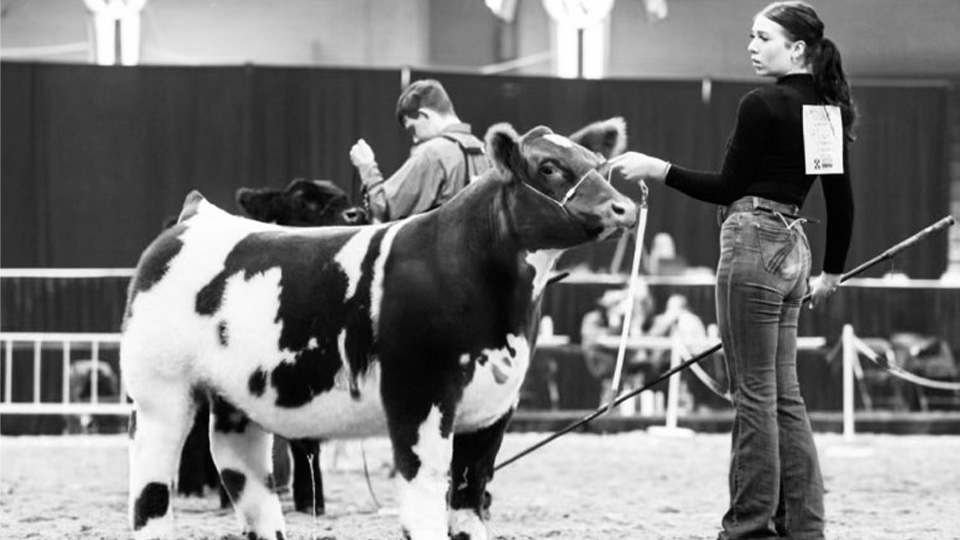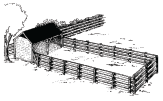First-Time Market Steer

Introduction
Congratulations on your decision to join one of the most hands-on 4-H activities out there! This fact sheet is designed
for first-time steer projects to help prepare and guide you through the basic steps of your 4-H livestock project.
Preparation
Registering for 4-H

Contact your local Utah State University Extension 4-H office to find out how to join a 4-H club and where to register for 4-H.
Reading the Rules
Determine where you plan to show your animal and read the rules and requirements for your project, including information like:
- Tagging dates.
- Ownership length requirements.
- Minimum and maximum weights.
- Show dates, check in-dates, weigh days.
- Rules related to the specific show.
Finding a Mentor
Find a mentor who has shown steers before to help guide you through the process. This can be an older 4-H or FFA member, a leader, or a community member who has shown in the past.
Developing a Budget for Common Expenses

It is important to understand where and how your money is working for you when it comes to raising 4-H project animals. Tracking your expenses and incomes will help you decide future management decisions like selection, housing, supplements, feed, and transportation. Some common areas to consider include the following.
- Purchase amount: Shop around and see what show steers in the area are selling for. Steer prices will vary widely depending on quality, breeder, breed, etc. The important part of budgeting is having a price limit in mind that you can afford and then shopping around for animals that fit in that price range.
- Housing: Animals should be penned in areas with proper footing, ventilation, shade, and free from any objects that may cause harm. Additionally, build pens with materials that will keep your project animals in and predators out.
- Water: All show animals need access to fresh water. Water should be kept in the shade and cleaned out regularly.

- Feed: Consult with your local feed store or 4-H group leader to learn more about steer nutrition. As a rule, growing show steers should eat approximately 2% of their body weight per day. They should get a quality grain mix with a good amount of protein. Protein for a steer’s feed should be 11% to 13%. You will also want to ensure you add in high-quality hay as well.
- Vet care: While there usually are not many vet care expenses for a market animal, you should always budget several hundred dollars in case you must address an emergency. Talk to your breeder or vet to make sure all vaccinations and wormers are up-to-date.

-
- Routine preventative care: Remember you are raising an animal destined for food production, so there are withdrawal periods on medications that apply to your animal. Please read each label carefully and consult a veterinarian before any treatment.
- Supplies: To properly prepare and manage your animal for your desired show, consider the following must- haves.
- Halter. Obtain a nylon halter ½ inch to ⅝ inch in diameter for training, and a show halter for the show.
- Shampoo or dish soap. Wash and clean the steer regularly.

- Show stick. Find a show stick that is the right size and length that works for you. This is how you will train your steer to stand correctly.
- Clippers. Clip steers before the show to have a cleaner appearance and allow the judge to see more of the muscles. Purchasing a set of clippers and blades is highly recommended, especially as show day approaches and the demand for communal/group supplies increases. Owning your own set of clippers and blades also ensures biosecurity and minimizes spreading disease.

-
- Trimming chute. This allows you to protect yourself as you start to groom and trim your steer.
- Comb. Used to keep the hair looking fluffed, you will use a comb daily to keep the hair healthy and your calf calm. Use plastic combs as they won’t cause injury to you or your steer if stepped on. Metal combs should only be used on show day.
- Trimming chute. This allows you to protect yourself as you start to groom and trim your steer.
- Halter. Obtain a nylon halter ½ inch to ⅝ inch in diameter for training, and a show halter for the show.
Select an Animal
Finding a Breeder
Contact a reputable breeder in your area. Ask kids in the community who have shown where they get their animals and what they look for in a breeder. Most breeders are willing to help with a feed program and progress reports throughout your project. There are also many online sale sources. Join local livestock social media pages to find more options.
Choosing the Right Size
Select an animal that will be the right size for your county fair. You will want your steer to be between 17–24 months of age when you show it and average 1,000–1,400 pounds. You will usually select your animal at around 8 months of age, and it should weigh around 500 pounds. Check your local rules to ensure you know the minimum weight requirement for fair weigh-in.
Bring Your Animal Home
Obtaining Papers
- One difference with steers than other show animals is having a bill of sale and brand inspection papers. Make sure to obtain these papers from the seller when you purchase your steer.
- If buying from out of state, make sure to call the Utah Department of Agriculture and Food to follow the proper importation procedures.
Housing

- Have a safe and secure pen set up, including clean water and feed. Make sure it has shelter from the sun, wind, and rain. Keeping a steer cool during hot weather is extremely important to keep the hair growth.
- Using shavings or straw in your steer’s pen helps keep him comfortable and clean. Pens should be cleaned daily.
- A smaller pen makes it easier to catch your steer when starting to work with him. Working with your steer as early as possible sets you up for more success.
Feeding and Gaining Weight
- Try to find out what the breeder has been feeding your animal, purchase the same food, or get a small quantity from the breeder to make a gradual shift to a food of your choice.
- Check with your local feed companies to see what food they have for your species of animal and how fresh and frequently they get it in stock.
- Do not mix feed across species; some feeds can be toxic to other species.
- Pick a feed and stick with it! It can cause stomach upset if you are constantly switching feed. It can also decrease weight gain.
- Regularly weigh your animal and adjust the feed.
- Check with your local FFA chapter; they usually have summer weigh days.
- Average daily weight gain will vary depending on your destination show but should range somewhere between 2–3 pounds per day.
Training
- Halter-breaking is one of the key components to training your steer.
- Start by using a nylon rope halter on the steer and tie him to a secure fence post about eye level. You should always use a slip knot to tie up your steer.
- Depending on your schedule, tie up your steer for up to 4 hours at a time. When starting this process, make sure to stay with him for safety reasons.
- When untying your steer, do not let go of the halter; he needs to know he can’t get away with it.
- When tied up, get your steer used to being touched. Brush and comb your steer and talk to it; you are its new friend.
- Remember to stay patient and calm while working with your steer; he can sense your emotions.
- When teaching to lead, pull gently on the rope toward you, give him slack, and see if he responds to the cue to move. Increase pressure as needed to get your steer to step forward; when he moves, reward him by giving slack on the halter.
- Slowly start getting your steer out of its pen and familiar with its surroundings. Introducing him to different environments makes him less likely to act up at the show.
Managing Health
- Deworm your animal when you first bring it home. Follow your local veterinarian’s advice for frequency, dosage, and type of wormer to use.
- Watch for any abnormal health concerns and contact a veterinarian immediately if you observe any of the following:
- Diarrhea.
- Not eating or drinking.
- Coughing.
- Lameness.
- Scabs or hair loss.
- Nasal and eye discharge.
Grooming
- Comb your steer as much as possible; this will help keep it calm and keep the hair healthy.
- Rinse and wash your steer and comb its hair in an upward direction until it is dry.
- If you have a blower, you can use this to dry its hair.
- Clipping your steer for the show can help hide flaws or enhance the appearance.
- You can watch many different YouTube videos to see how to clip your steer.
Photo Credits
The cover page image is courtesy of H. Murray and used with permission; the other photo was provided by Utah State University Extension.
References
- Gosz, R., & Bacon, C. (2017, February 1). Beef showmanship [Fact sheet]. Oklahoma State University. https://extension.okstate.edu/fact-sheets/beef-showmanship.html
- Wilke, K., (2023, November 1). Helping your child feed their 4-H or FFA market steer [Fact sheet]. University of Nebraska. https://beef.unl.edu/beefwatch/2023/helping-your-child-feed-their-4-h-or-ffa-market-steer.
April 2024
Utah State University Extension
Peer-reviewed fact sheet
References
- Complete Guide to Home Canning (Agriculture Information Bulletin No. 539). 1994. USDA & Extension Service.
- Drost, Dan. 2005. Beans in the Garden. Utah State University Extension. Logan, Utah.
Authors
Ashley T. Longmore, USU Extension Assistant Professor,Box Elder County
Cheyenne A. Reid, USU Extension Assistant Professor,Uintah County
Related Research


 Staff Resources
Staff Resources
